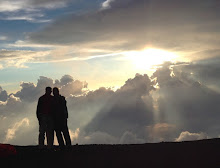 Last night Tom went to close up the shop and realized the army ants were on the move. This is actually a very narrow stream of them; sometimes they move in a mass 10 or 12 feet wide, and it can take a swarm of them an hour to pass. With these narrow streams, it’s easy enough to jump over them, but if they’re in a mass too wide to jump, you have to either try to go around, or run through as fast as you can – and you’ll still get bit a few times. They’re actually sort of cool, because they swarm through the jungle cleaning up everything. You can tell when you’re near an army of ants on the move because you can here buzzing and rustling in the leaves on the ground as everything tries to get out of their way. We haven’t had them in the house because our house is up on metal-capped poles, but we’re told that if an accessible house is in their path, they’ll go right through – and that’s a good thing, because they’ll get rid of scorpions, spiders, other ants, and any other type of bug in their way.
Last night Tom went to close up the shop and realized the army ants were on the move. This is actually a very narrow stream of them; sometimes they move in a mass 10 or 12 feet wide, and it can take a swarm of them an hour to pass. With these narrow streams, it’s easy enough to jump over them, but if they’re in a mass too wide to jump, you have to either try to go around, or run through as fast as you can – and you’ll still get bit a few times. They’re actually sort of cool, because they swarm through the jungle cleaning up everything. You can tell when you’re near an army of ants on the move because you can here buzzing and rustling in the leaves on the ground as everything tries to get out of their way. We haven’t had them in the house because our house is up on metal-capped poles, but we’re told that if an accessible house is in their path, they’ll go right through – and that’s a good thing, because they’ll get rid of scorpions, spiders, other ants, and any other type of bug in their way.We’ve seen a number of interesting birds around here in the past couple of weeks, although we haven’t had the camera handy for pictures. I was walking behind the guest cabin and heard big wing beats and breaking twigs, and turned around just in time to see a laughing falcon heading up through the canopy with a snake in its talons. It stopped on a branch so I could get a good look at it, and then flew deeper into the leaves with the still-wriggling snake. I (of course) looked the laughing falcon up in the bird book and found that their diet consists mainly of snakes, both venomous and non-venomous. Now we know why they sometimes sound so hysterical as they “laugh” in the jungle.
I also saw a collared forest falcon in the trees near the back pasture last week. I knew as soon as I saw it that it wasn’t one of the more common raptors we see around here, but I followed it through three flights and landings and got a good enough look at it that I could make a positive identification from the bird book. This website has a decent picture – which is actually a painting – and information about the bird. This website has a good audio of the very distinctive cry of this bird; click the first audio link. Tom and I had been hearing this cry for a while and didn’t know what it was because it’s somewhat like the laughing falcon’s call, but the laughing falcon’s call is much less extended.
One morning as we were eating breakfast we were watching the Great Kiskadees hopping around in the trees in the yard. They seem to be getting almost tame, and will perch on branches right outside the porch screening - no doubt wondering why the people are in a cage. This particular morning we were startled when one of the kiskadees suddenly launched itself off the branch right at the screening, and grabbed a clackety-clack butterfly right out of the air right in front of our faces. The Kiskadee took the butterfly to a nearby branch and enjoyed breakfast with us. By the way, we don't know the real name of the clackety-clack butterflies, but we gave them that name because they fly around the citrus trees and make a very loud clacking sound which sounds like a loud electrical short, presumably part of a mating ritual. Here's the mangoverde link for the Great Kiskadee.
As we were riding up the government feeder road between our two lots the other day, we saw a number of violaceous trogons in the trumpet trees. They’re fairly common in the area, but we don’t usually see them right around our house, and for some reason we consider the trogons an interesting sighting. We’re not quite sure why, except that they’re colorful and distinctive – sort of like the toucans, which we also see regularly, but which still give us a thrill. This website has pictures, information, and audio clips of the violaceous trogons.



No comments:
Post a Comment